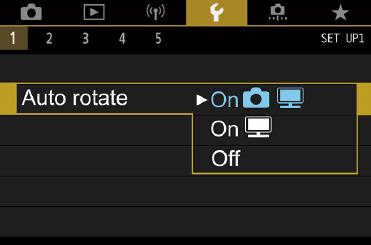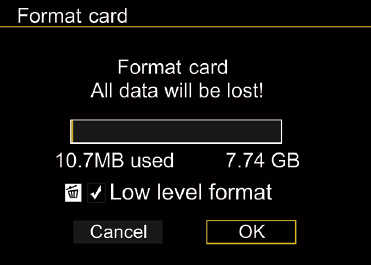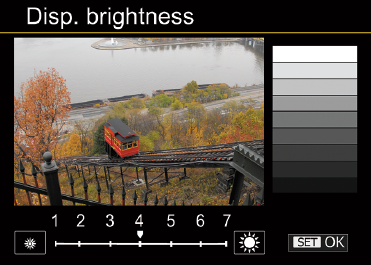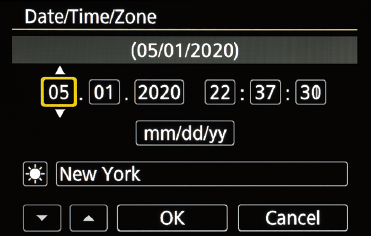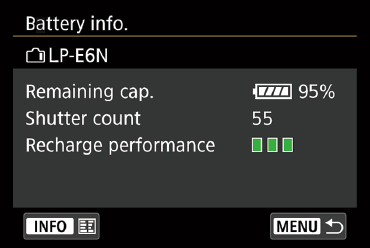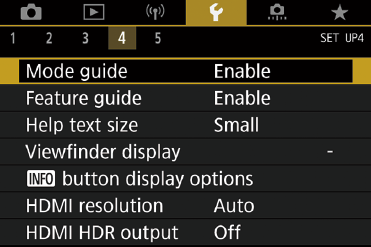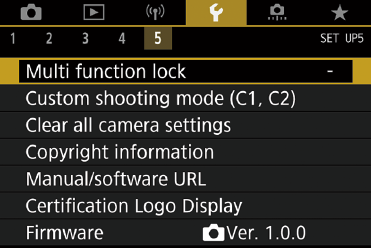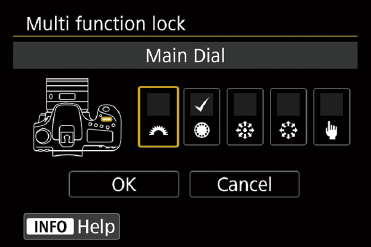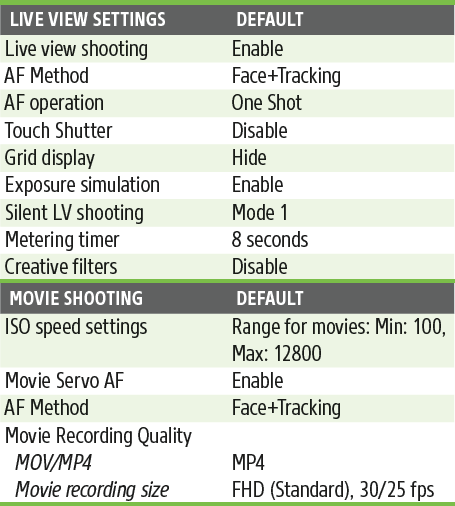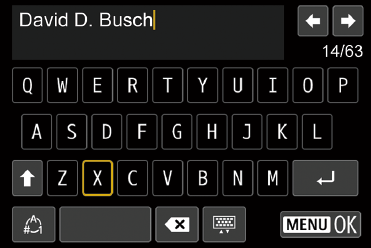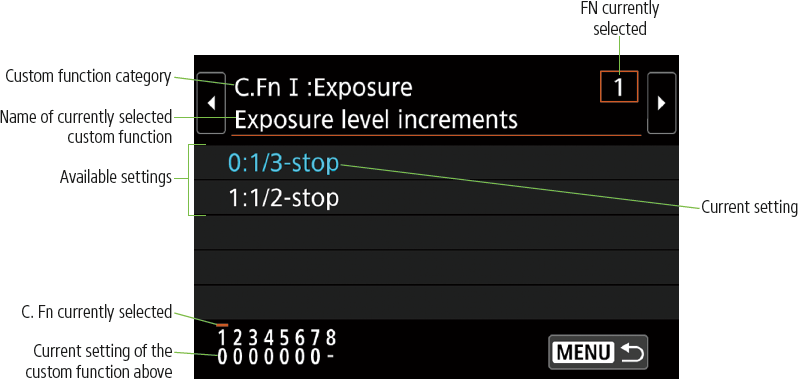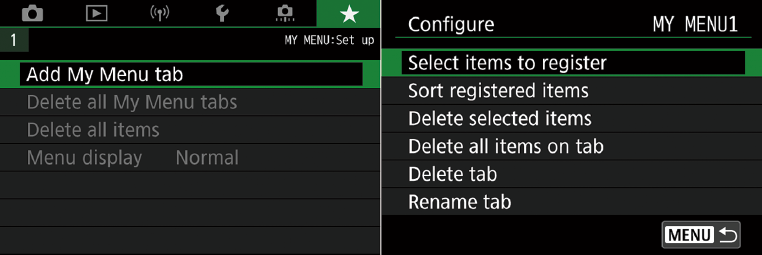In Chapter 7, I introduced you to the layout and general functions of the Canon EOS 90D’s menu system, with specifics on how to configure your camera with the Shooting and Playback menus. In this chapter, you’ll learn how to work with the Set-up menus, tailor specific features using Custom Functions, and how to assemble your own roster of favorite menu listings with the My Menu feature.
If you’re jumping directly to this chapter and need some guidance in how to navigate the 90D’s menu system, review the first few pages of Chapter 7. Otherwise, you’re welcome to dive right in.
Set-up Menu Options
There are five amber-coded Set-up menus where you adjust how your camera behaves during your shooting session, as differentiated from the Shooting menu, which adjusts how the pictures are actually taken. Your choices when shooting stills include:
Set-up 1
- Select Folder
- File Numbering
- Auto Rotate
- Format Card
Set-up 2
- Auto Power Off
- Display Brightness
- Screen Off/On Button
- Date/Time/Zone
- Language
Set-up 3
- Video System
- Touch Control
- Beep
- Headphone Volume
- Battery Info.
- Sensor Cleaning
Set-up 4
- Mode Guide
- Feature Guide
- Help Text Size
- Viewfinder Display
- INFO. Button Display Options
- HDMI Resolution
- HDMI HDR Output
Set-up 5
- Multi Function Lock
- Custom Shooting Mode (C1, C2)
- Clear All Camera Settings
- Copyright Information
- Manual/Software URL
- Certification Logo Display
- Firmware
Select Folder
Options: Select Folder, Create Folder
My preference: N/A
Choose this menu option, the first in the Set-up 1 menu (see Figure 9.1) to create a folder where the images you capture will be stored on your memory card, or to switch between existing folders. Just follow these steps:
- 1. Choose Select Folder. Access the option from the Set-up 1 menu.
- 2. View list of available folders. The Select Folder screen pops up with a list of the available folders on your memory card, with names like 100CANON, 101CANON, etc.
Figure 9.1 The Set-up 1 menu.
- 3. Choose a different folder. To store subsequent images in a different existing folder, use the touch screen or multi-controller to highlight the label for the folder you want to use. When a folder that already has photos is selected, two thumbnails representing images in that folder are displayed at the right side of the screen.
- 4. Confirm the folder. Choose SET to confirm your choice of an existing folder.
- 5. Create new folder. If you’d rather create a new folder, highlight Create Folder in the Select Folder screen and choose SET. The name of the folder that will be created is displayed, along with a choice to Cancel or OK creating the folder. Choose SET to confirm your choice.
- 6. Exit. Press MENU to return to the Set-up 1 menu.
The folders your 90D create always follow the nnnCANON convention. You can also use your computer to create folders with names that depart from this arrangement, as long as you adhere to the camera’s general rules for memory card folder names. Here’s how to create folders with personalized names:
- 1. Access the memory card from your computer. There are two ways to do this.
- USB link. Plug the optional mini-B USB cable into the port on the left side of the 90D and connect to a USB connector on your computer. In Windows, the 90D will appear as a generic digital camera icon. A similar icon will appear on the Mac OS X desktop.
- Use a card reader. Remove the card from the 90D and insert it in a card reader attached to your computer.
- 2. Open the camera/memory card in your computer. A folder called DCIM will appear at the top level. All the folders your 90D can access must be located inside the DCIM folder.
- 3. Create a new folder within the DCIM folder. Although you’re not limited to the nnnCANON arrangement, you must adhere to the rules in the steps that follow.
- 4. Type in a three-digit folder number. You can use any three numbers from 100 to 999, as long as those numbers are not already in use on that memory card. In other words, you can’t have folders named 101CANON and 101SPAIN.
- 5. Add a five-character description of your choice. You can use any uppercase or lowercase letters from A to z, plus the underscore character (to represent a space). You cannot use an actual space, nor any other characters, even if your computer allows them in a filename. An invalid folder name will end up being “invisible” to the 90D, even if it exists on your memory card.
With a little imagination (and caution, to avoid creating “bad” folder names), you can develop some useful folder names, and switch among them at will. I find this capability especially useful when working with large (32GB or 64GB) cards, because I can do a great deal of organizing right on the card itself. Perhaps I have some images in a folder that I use as a “slide show” for display on my 90D’s back-panel LCD. Or, I might want to sort images by location or date. For example, I could use 104_ USA_, 105SPAIN, 106FRANC, or 107GBRIT to indicate the location where the images were shot.
File Numbering
Options: Continuous (default), Auto Reset, Manual Reset
My preference: N/A
The EOS 90D will automatically apply a file number to each picture you take, using consecutive numbering for all your photos over a long period of time, spanning many different memory cards, starting over from scratch when you insert a new card, or when you manually reset the numbers. Numbers are applied from 0001 to 9999, at which time the camera creates a new folder on the card (100, 101, 102, and so forth), so you can have 0001 to 9999 in folder 100, then numbering will start over in folder 101.
The camera keeps track of the last number used in its internal memory. That can lead to a few quirks you should be aware of. For example, if you insert a memory card that had been used with a different camera, the 90D may start numbering with the next number after the highest number used by the previous camera. (I once had a brand-new 90D start numbering files in the 8,000 range.) I’ll explain how this can happen next.
On the surface, the numbering system seems simple enough: In the menu, you can choose Continuous, Automatic Reset, or Manual Reset. Here is how each works:
- Continuous. If you’re using a blank/reformatted memory card, the 90D will apply a number that is one greater than the number stored in the camera’s internal memory. If the card is not blank and contains images, then the next number will be one greater than the highest number on the card or in internal memory. (In other words, if you want to use continuous file numbering consistently, you must always use a card that is blank or freshly formatted). Here are some examples.
- You’ve taken 4,235 shots with the camera, and you insert a blank/reformatted memory card. The next number assigned will be 4,236, based on the value stored in internal memory.
- You’ve taken 4,235 shots with the camera, and you insert a memory card with a picture numbered 2,728. The next picture will be numbered 4,236.
- You’ve taken 4,235 shots with the camera, and you insert a memory card with a picture numbered 8,281. The next picture will be numbered 8,282, and that value will be stored in the camera’s menu as the “high” shot number (and will be applied when you next insert a blank card).
- Automatic Reset. If you’re using a blank/reformatted memory card, the next photo taken will be numbered 0001. If you use a card that is not blank, the next number will be one greater than the highest number found on the memory card. Each time you insert a memory card, the next number will either be 0001 or one higher than the highest already on the card.
- Manual Reset. The 90D creates a new folder numbered one higher than the last folder created and restarts the file numbers at 0001. Then, the camera uses the numbering scheme that was previously set, either Continuous or Automatic Reset, each time you subsequently insert a blank or non-blank memory card.
Auto Rotate
Options: On: Camera, Computer (default); On: Computer Only; Off
My preference: N/A
You can turn this feature On or Off. When activated, the EOS 90D rotates pictures taken in vertical orientation on the LCD screen so you don’t have to turn the camera to view them comfortably. However, this orientation also means that the longest dimension of the image is shown using the shortest dimension of the LCD, so the picture is reduced in size. You have three options, shown in Figure 9.2. The image can be autorotated when viewing in the camera and on your computer screen using your image editing/viewing software. The image can be marked to autorotate only when reviewing your image in your image editor or viewing software. (This option allows you to have rotation applied when using your computer, while retaining the ability to maximize the image on your LCD in the camera.) The third choice is Off. The image will not be rotated when displayed in the camera or with your computer. Note that if you switch Auto Rotate off, any pictures shot while the feature is disabled will not be automatically rotated when you turn Auto Rotate back on; information embedded in the image file when the photo is taken is used to determine whether autorotation is applied.
Figure 9.2 Choose auto rotation both in the camera and on your computer display (top); only on your computer display (middle); or no automatic rotation (bottom).
Format Card
Options: Format, Low-Level Format
My preference: N/A
Figure 9.3 You must confirm the format step before the camera will erase a memory card.
Use this item to erase everything on your memory card and set up a fresh file system ready for use. When you select Format Card, you’ll see a display like Figure 9.3, showing the capacity of the card, how much of that space is currently in use, and two choices at the bottom of the screen to Cancel or OK (proceed with the format). Press the Trash button if you’d like to do a low-level format. That’s a more basic format that removes all sectors from the card and creates new ones, which can help speed up a card that seems to be slow (because the camera must skip over “bad” sectors left behind from previous uses). An orange bar appears on the screen to show the progress of the formatting step.
Auto Power Off
Options: 30 sec. (default), 1 min., 2 min., 4 min., 8 min., 15 min., Disable
My preference: 1 min.; 4 min. when shooting sports
This setting, the first in the Set-up 2 menu (see Figure 9.4), allows you to determine how long the EOS 90D remains active before shutting itself off. You can select 30 seconds, 1, 2, 4, 8, or 15 minutes, or Off (disable), which leaves the camera turned on indefinitely. However, even if the camera has shut itself off, if the power switch remains in the On position, you can bring the camera back to life by pressing the shutter button.
Figure 9.4 The Set-up 2 menu.
Display Brightness
Options: Adjust LCD monitor brightness
My preference: N/A
Choose this menu option and a thumbnail image with a grayscale strip appears on the LCD, as shown in Figure 9.5. You can use the touch screen, multi-controller pad, or the Main Dial to adjust the brightness to a comfortable viewing level. Use the gray bars as a guide; you want to be able to see both the lightest and darkest steps at top and bottom, and not lose any of the steps in the middle. Brighter settings use more battery power but can allow you to view an image on the LCD outdoors in bright sunlight. When you have the brightness you want, select SET to lock it in and return to the menu.
Figure 9.5 Adjust LCD brightness for easier viewing under varying ambient lighting conditions.
Screen Off/On Button
Options: Shutter Btn (default), Remains On
My preference: Remains On
When composing images in shooting mode, the shooting settings display on the LCD monitor remains on until you turn it off by pressing the INFO. button. This entry allows you to switch from the default Remains On setting to the Shutter Btn option, which turns off the monitor display when you press the shutter button halfway, and switches it back on when you release the button.
Some prefer to have the settings screen shown all the time, or until they turn it off or on manually using the INFO. button; the Remains On option provides that behavior. But, ordinarily, when you’re pressing the shutter release halfway, you’re peering through the viewfinder and can’t see or don’t need the shooting settings display, anyway, so the Shutter Btn option may be a good choice—for example, if you’re shooting under reduced light levels, having the LCD monitor display switch off automatically as you make an exposure (eliminating a potential distraction), then re-appear between shots.
Date/Time/Zone
Options: Date, Time, Date Format, Time Zone
My preference: N/A
Use this option to set the date and time, which will be embedded in the image file along with exposure information and other data. As first outlined in Chapter 1, you can set the date and time by following these steps:
- 1. Access this menu entry from the Set-up 2 menu.
- 2. Rotate the QCD to move the highlighting down to the Date/Time entry.
- 3. Press the SET button in the center of the QCD to access the Date/Time setting screen, shown in Figure 9.6.
- 4. Rotate the QCD to select the value you want to change. When the gold box highlights the month, day, year, hour, minute, or second format you want to adjust, press the SET button to activate that value. A pair of up-/down-pointing triangles appears above the value.
Figure 9.6 Set the date, time, and time zone here.
- 5. Rotate the QCD to adjust the value up or down. Press the SET button to confirm the value you’ve entered.
- 6. Repeat steps 4 and 5 for each of the other values you want to change. The date format can be switched from the default mm/dd/yy to yy/mm/dd or dd/mm/yy; you can turn Daylight Saving Time on or off and choose an appropriate time zone.
- 7. When finished, rotate the QCD to select either OK (if you’re satisfied with your changes) or Cancel (if you’d like to return to the Set-up 2 menu without making any changes). Press SET to confirm your choice.
- 8. When finished setting the date and time, press the MENU button to exit, or just tap the shutter release.
Language
Options: 29 languages
My preference: English
Choose from 29 languages for menu display, rotating the multi-controller pad until the language you want to select is highlighted. Press the SET button to activate. Your choices include English, German, French, Dutch, Danish, Portuguese, Finnish, Italian, Ukrainian, Norwegian, Swedish, Spanish, Greek, Russian, Polish, Czech, Magyar, Vietnamese, Hindi, Romanian, Turkish, Arabic, Thai, Simplified Chinese, Traditional Chinese, Korean, Malaysian, Indonesian, and Japanese.
Video System
Options: NTSC, PAL
My preference: N/A
This setting, the first on the Set-up 3 menu (see Figure 9.7), controls the output of the 90D through the AV cable when you’re displaying images on an external monitor. You can select either NTSC, used in the United States, Canada, Mexico, many Central American, South American, and Caribbean countries, much of Asia, and other countries, or PAL, which is used in the UK, much of Europe, Africa, India, China, and parts of the Middle East.
Figure 9.7 The Set-up 3 menu.
VIEWING ON A TELEVISION
Canon makes it quite easy to view your images on a standard television screen, and not much more difficult on a high-definition television (HDTV). For HDTV display, purchase the optional HDMI Cable HTC-100 and connect it to the HDMI OUT terminal just below the USB/digital terminal on the left side of the camera.
Connect the other end to an HDMI input port on your television or monitor (my 42-inch HDTV has three of them; my 26-inch monitor has just two). Then turn on the camera and press the Playback button. The image will appear on the external TV/HDTV/monitor and will not be displayed on the camera’s LCD. HDTV systems automatically show your images at the appropriate resolution for that set.
Touch Control
Options: Standard (default), Sensitive, Disable
My recommendation: Standard
Here you can specify how sensitive the touch screen is to your taps and strokes. Note that the screen responds to changes in capacitance (changes in an electrical charge), rather than pressure, so using a stylus or other object instead of a finger isn’t advised. Moisture or protective covers for the LCD screen may also interfere with touch operation, although I’ve had no problems with GGS screens available from Amazon and elsewhere. If you find that your everyday handling of the 90D frequently triggers unwanted actions, you can disable touch control entirely if you never want to use it. Otherwise, set the amount of sensitivity that works best for digital control, so to speak. While Standard works best for most, those who use touch control frequently may want to try the Sensitive setting. However, at that setting, very rapid, light movements may not register.
Beep
Options: Enable (default), Disable Touch Screen Sounds, Disable
My preference: Disable
The 90D’s internal beeper provides a helpful chirp to signify various functions, such as the countdown of your camera’s self-timer, when an image is in focus, and during touch operations. You can switch it off entirely if you want to avoid the beep because it’s annoying, impolite, or distracting (at a concert or museum), or undesired for any other reason. In the Beep screen, choose Enable to activate, Disable to silence all beeps, or Disable Touch Screen Sounds (which silences the beep only during touch screen operations), as you prefer. Press SET to activate your choice and exit.
Headphone Volume
Options: Volume level 0 to 15
My preference: N/A
When shooting movies, you can monitor sound being recorded with headphones plugged into the headphone terminal of the 90D. This setting allows you to specify one of 16 different playback levels, from 0 (off) to 15 (quite loud). This adjustment is applied only when the Sound Recording entry in the Movie Shooting 1 menu is set to Auto or Manual. You’ll learn more about capturing video in Chapter 10.
Battery Info.
Options: Information display of battery capacity, battery life
My preference: N/A
This entry is an exceptionally useful feature that allows you to view battery condition information and performance and track the data among several different batteries. Your EOS 90D can keep track of multiple LP-E6/LP6N batteries because each of them is given a unique serial number (which is printed on an included sticker you can affix to the battery). The camera reads this serial number and stores information about each of the batteries that you use and have “registered” separately. I always recommend owning at least two and, preferably three or more batteries. That’s especially true if you use the Battery Grip BG-E14, which holds two battery packs itself. I also own other Canon cameras which use the same battery, so I’m able to justify four batteries to shuttle between my two cameras.
This feature makes it possible to see exactly how each battery you own is performing, allows you to rotate them to even out the usage, and helps you know when it’s time to replace a battery. When you select this menu choice, a Battery info screen appears, with a wealth of information (if you use two LP-E6 packs in a BG-E14 grip, information about both packs will appear). (See Figure 9.8.)
Figure 9.8 Battery information.
- Battery position. The second line of the screen includes an icon that shows where the battery currently being evaluated is installed (usually the hand grip if you’re not using the BG-E14).
- Power type. Next to the position icon is an indicator that shows the model number of the battery installed or shows that the DC power adapter is being used instead.
- Remaining capacity. The Battery check icon appears showing the remaining capacity visually, along with a percentage number that reads out in 1% increments. You can use this as a rough gauge of how much power you have remaining. If you’re in the middle of an important shooting session, you might want to switch to a fully charged battery at the 25%–33% level to avoid interruptions at the worst probable time. (If you’re using six AA batteries in the BG-E14 grip instead of LP-E6/LP-E6N packs, only this battery capacity notice will appear; the other indicators are not shown.)
- Shutter count. Displays how many times the shutter has been actuated with the current charged battery. This info can help you learn just how much certain features cost you in terms of power. For example, if a battery has only 50 percent of its power remaining, but you’ve taken only a few dozen photos, you know that your power is being sapped by picture review, lots of autofocus, frequent image stabilization because of lower shutter speeds, or (a major culprit) that flip-up flash you’ve been using. While in most cases knowledge is power, in this instance knowledge can help you save power, with a tip-off to use fewer juice-sapping features if the current battery pack must be stretched as far as possible.
- Recharge performance. This indicator shows how well your battery pack is accepting and holding a charge. Three green bars mean that the pack’s performance is fine; two bars show that recharge performance is degraded a little. A red bar indicates that your pack is on its last legs and should be replaced soon. To lengthen the service time of your batteries, you might want to rotate usage among several different packs, so they all “age” at roughly the same rate.
Registering Your Battery Packs
The EOS 90D can “remember” information about up to six battery packs and provide readouts of their status individually. To register the battery currently in your camera, follow these steps:
- 1. Access the Battery Info. screen from the Set-up 3 menu.
- 2. Press the INFO. button, located to the left of the LCD screen.
- 3. Information about the current battery, including its serial number and the current date, will be shown on a new screen.
- 4. Choose Register to log the battery; if the pack has already been registered, you can choose Delete Info. to remove the battery from the list. (You’d want to do this if you already registered the limit of six batteries and want to add another one.)
- 5. Press SET to add the battery to the registry.
- 6. If you’re deleting a battery, the 90D shows you a Battery Info. delete screen instead. (You can delete a battery pack without having that battery installed in the camera—which could come in handy if you lose one.) Just select the battery (by serial number) and delete.
- 7. Press MENU to back out of any of the Battery Info. screens.
- 8. Once a battery has been registered, you can check on its remaining capacity at any time (even if it isn’t currently installed in the 90D) from the Battery info page. The camera remembers and updates the status of each registered battery whenever it is inserted in the 90D. The date the battery was last used is also shown.

TIPUse this info with caution, however, as a given battery may have self-discharged slightly during storage and, of course, you may have fully recharged it since the last time it was inserted in the camera. However, this data can be useful in tracking the remaining capacity of several different battery packs during a single shooting session, or over the course of several days when you’re not recharging the packs at the conclusion of each session.
Sensor Cleaning
Options: Auto Cleaning: Enable/Disable; Clean Now; Clean Manually
My preference: Auto Cleaning: Enable
One of the Canon EOS 90D’s most useful features is the automatic sensor cleaning system that reduces or eliminates the need to clean your camera’s sensor manually. Canon has applied anti-static coatings to the sensor and other portions of the camera body interior to counter charge build-ups that attract dust. A separate filter over the sensor vibrates ultrasonically each time the 90D is powered on or off, shaking loose any dust.
Use this menu entry to enable or disable automatic sensor cleaning on power up (select Auto Cleaning to choose) or to activate automatic cleaning during a shooting session (select Clean Now). You can also choose the Clean Manually option to flip up the mirror and clean the sensor yourself with a blower, brush, or swab. If the battery level is too low to safely carry out the cleaning operation, the 90D will let you know and refuse to proceed, unless you use the optional AC Adapter Kit ACK-E6N.
Mode Guide
Options: Enable (default), Disable
My preference: Disable after you’re familiar with what each Mode does
This is the first entry on the Set-up 4 menu (see Figure 9.9). The Mode Guide display describes the function of each position on the Mode Dial when you rotate the dial to that position. In some cases, the text that pops up is useful only for the newest user. For example, rotate the dial to Tv, and you’ll see a message: “Set Your Preferred Shutter Speed.” However, if you press the down directional button more information appears: “Adjust shutter speed to make moving subjects look still or capture motion blurring.” The instructional screen quickly vanishes in a few seconds.
Figure 9.9 The Set-up 4 menu.
I generally leave the Mode Guide turned off. If you frequently use the C1 or C2 user settings, though, you may find it useful, as the display will tell you which shooting mode (say, Tv or Av) has been assigned to that particular memory slot.
Feature Guide
Options: Enable (default), Disable
My preference: Disable after you’re familiar with the camera’s key features
The Feature Guide is an easy pop-up description of a function or option that appears when you use the Quick Control screen to make an adjustment. The instructional screen quickly vanishes in a few seconds. You can use this setting to enable or disable the Feature Guide.
Help Text Size
Options: Small (default), Large
My recommendation: Large
When you first begin using your 90D, you may find yourself pressing the INFO. button when the INFO. Help message is displayed below a menu. Pressing it will pop up a screen with information on how to choose options for that menu item. You won’t need this help after you’ve had your camera for a while, but if you avail yourself of this aid, you might as well have it displayed in large, clear text. You can press the up/down directional buttons to scroll within the help text display.
Viewfinder Display
Options: Electronic Level: Show, Hide (default); Grid Display: Show, Hide (default); Flicker Detection: Show (default), Hide
My preference: N/A
Although the optical viewfinder can’t display as many different graphics as the LCD monitor, certain indicators, such as the electronic level, grid display, and flicker detection warning can be shown. This option allows you to enable or disable display of these viewfinder graphics. By default, only Flicker Detection is displayed.
INFO. Button Display Options (Viewfinder Mode)
Options: Electronic Level: Enable (default), Disable; Quick Control Screen: Enable (default), Disable
My preference: Disable electronic level
When you press the INFO. button on the back of the 90D, by default the LCD screen display cycles among blank screen (off), electronic level, and Quick Control screen. You can use this setting to disable either the electronic level or Quick Control screen (but not both). I generally use the electronic level only when shooting landscapes or architecture, so I tend to disable it. In that mode, pressing the INFO. button simply toggles between blank screen (off) and the Quick Control screen. I can view the QC screen immediately or turn it off with a single press of the INFO. button.
Shooting Information Display (Live View Mode)
Options: Screen Information Settings; Grid Display: Off (default), 3 × 3, 6 × 4, 3 × 3+Diagonal; Histogram: Brightness (default), RGB
My preference: N/A
In Live View mode, the INFO. Button Display Options entry is replaced by this one. It allows you to choose which of four possible information screens are displayed on the LCD screen, enable/disable three optional grid overlays, and toggle between Brightness (luminance) and RGB histograms. I’ll explain this entry in more detail in Chapter 10.
HDMI Resolution
Options: Auto (default), 1080p
My recommendation: 1080p if your device accepts it
As I mentioned earlier, your 90D can output to an external monitor or video recorder, using a cable that has an HDMI Mini-C connector to fit the camera and a standard HDMI connector on the other end to link to your device. You can set this option to Auto, in which case the camera will attempt to ascertain the correct resolution for the connected device, and then direct its output in that format. There may be some delay while the appropriate resolution is achieved, but it you know your device can accept 1080p video, you can go ahead and select that setting to avoid the time lag.
The only problem with this procedure is that the 90D has a nasty habit of not adjusting to the correct resolution for some devices, complicated by the fact that you cannot then select the right setting yourself. I’ve encountered several devices, including my BlackMagic Intensity Shuttle capture device, that the 90D is unable to recognize automatically, and which require a setting that Canon does not allow you to make manually. I checked with Canon and they offer no solution; there is no way to manually specify a resolution other than 1080p. Not cool.
HDMI HDR Output
Options: Off/On
My recommendation: N/A
Television innovations come and go, but some are more likely than others to catch on, and Canon is keeping abreast of the curve. Unlike, say, 3D TV (which suffered from a lack of content and consumer desire and had mercifully died by 2018), High Dynamic Range (HDR) TV is here to stay. If your current television doesn’t have HDR, it’s likely your next one will (along with 4K display). In that case, you’ll be able to output your 90D’s RAW images for display on your nifty new set. They’ll look mar-velous (at least, that’s what I’m told).
In addition to an HDR-compatible TV, you’ll need to remember to set up your television’s input to accept HDR images. While viewing HDR output from your camera, some features, such as RAW processing, are not available. The camera will also send JPEG images instead of RAW to your HDR TV when displaying multiple-exposure RAW images and photos shot with the L (ISO 50 equivalent) sensitivity setting.
Multi Function Lock
Options: Main Dial, Quick Control Dial (default), Multi-controller 1, Multi-controller 2, Touch Control
My preference: None
Figure 9.10 The fifth Set-up menu page.
This is the first entry in the Set-up 5 menu (see Figure 9.10). Your 90D includes a Lock switch located just below the Quick Control Dial. Slide it to the Lock position when you want to prevent the use of the QCD, Main Dial, multi-controller or QCD directional buttons, or touch controls from accidentally changing a setting. You can select any or all five of the controls (shown in Figure 9.11) to lock, while freeing the others (or none) to act normally. Note: The Multi-controller 1 setting locks/unlocks the multi-controller joystick’s directional functions; the Multi-controller 2 setting does the same thing for the Quick Control dial’s directional buttons.
Figure 9.11 Choose which controls to lock.
I use this sometimes when I am working with manual exposure, especially when I’m fumbling around in a darkened environment, and don’t want to unintentionally manipulate my settings. The Multi Function Lock screen has one option for each control; highlight the control and press SET to lock or unlock it. A check mark appears next to the control’s name when it’s locked, and an L/Lock indicator appears in the view-finder, top-panel LCD, and shooting settings display. Even if you’ve locked the QCD, its touch pad functions can still be used during movie shooting.
Custom Shooting Mode (C1/C2 Modes)
Options: Register settings
My preference: N/A
This entry allows you to register your EOS 90D’s current camera shooting settings and file them away in the C1 or C2 positions on the Mode Dial. Doing this overwrites any settings previously stored at the Camera user positions. You can also clear the settings for the C “slots,” returning them to their factory default values. To perform either of these tasks, just follow these steps:
- 1. Make your settings. Set the EOS 90D to an exposure mode other than Scene Intelligent Auto.
- 2. Access camera user settings. Navigate to the Custom Shooting Mode (C mode) option in the Set-up 5 menu, and press SET.
- 3. Choose function. Rotate the Quick Control Dial to choose Register if you want to store your 90D’s current settings in C1 or C2; or select Clear Settings if you want to erase the settings. Press SET to access the settings screen for your choice.
- 4. Store/Clear settings. The individual screens for storing/clearing are virtually identical. Use the QCD to highlight Mode Dial: C1/C2, and press SET to store or clear the settings for that position. (You’ll be given a choice to proceed or cancel first.)
- 5. Auto update. Keep in mind that if you change a setting while using the custom shooting mode and want to retain the new settings, your stored settings can be automatically updated to reflect the modifications. Select Auto Update Set. and choose Enable to activate this option. If you’d rather retain your custom settings until you manually decide to update, select Disable instead.
- 6. Exit. When you confirm, you’ll be returned to the Set-up 5 menu. Press the MENU button or tap the shutter release button to exit the menu system entirely.
Clear All Camera Settings
Options: Clear All Camera Settings, Clear All Custom Functions
My preference: N/A
This menu choice resets all the settings to their default values. Regardless of how you’ve set up your EOS 90D, it will be adjusted for One-Shot AF mode, Automatic AF point selection, Evaluative metering, JPEG Fine Large image quality, automatic ISO, sRGB color mode, automatic white balance, and Standard Picture Style. Any changes you’ve made to exposure compensation, flash exposure compensation, and white balance will be canceled, and any bracketing for exposure or white balance nullified. Custom white balances and Dust Delete Data will be erased. Remember, Custom Functions and Camera User Settings will not be cleared. If you want to cancel those, as well, you’ll need to use the Camera User Setting option (described previously) and the Custom Functions clearing option.
TABLE 9.1 Camera Setting Defaults
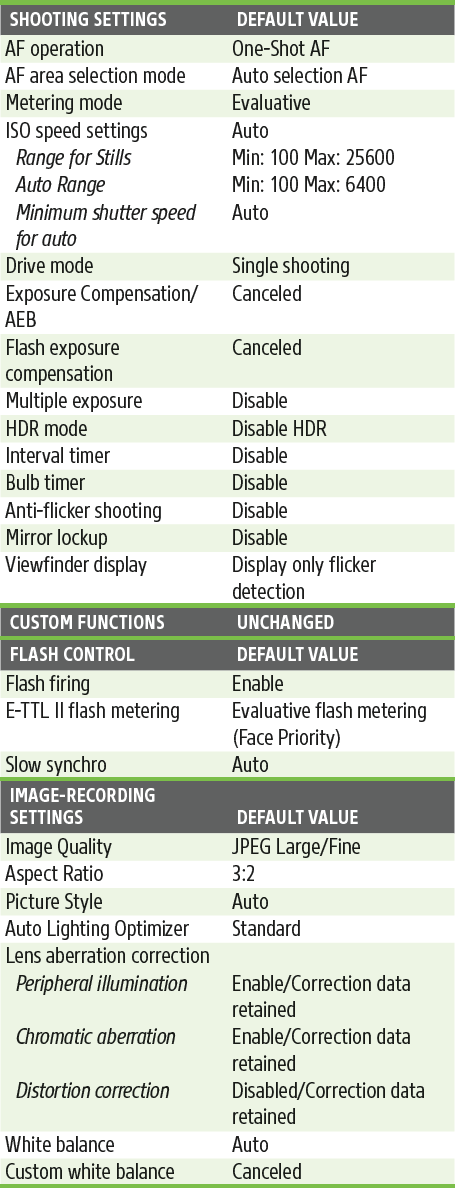
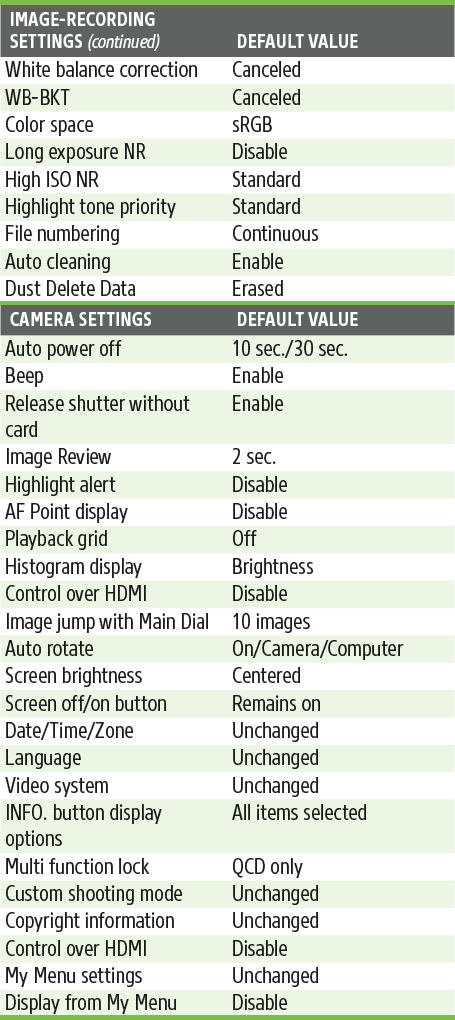
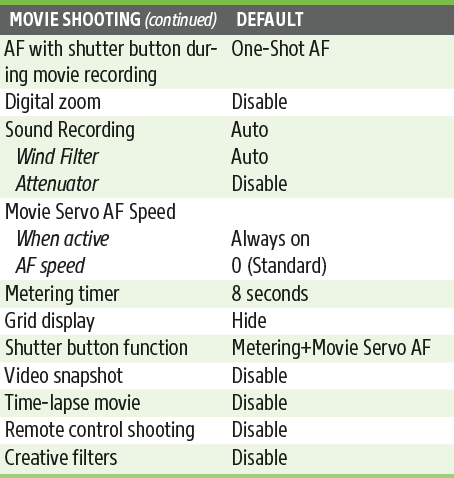
Copyright Information
Options: Display Copyright Info, Enter Author’s Name, Enter Copyright Details, Delete Copyright Information
My preference: N/A
You can embed your name (as “author” or auteur of the image) and copyright information in the Exif (Exchangeable Image File format) data appended to each photo that you take. When you choose this menu entry, you have four options:
- Display Copyright Info. Shows the current author and copyright data.
Figure 9.12 Select the alphanumeric characters for your text entry.
- Enter Author’s Name. Produces a text-entry screen like the one shown in Figure 9.12. See “Entering Text” for instructions on how to type in text for this screen and the Copyright Details screen.
- Enter Copyright Details. Produces the same text-entry screen, allowing you to enter copyright details. Oddly enough, no copyright symbol is available (although the @ sign is provided so you can type in your e-mail address!). Many just use the parentheses and a lowercase c: (c). However, you should know that this is, strictly speaking, not legal. The legit substitutes for the actual copyright symbol are the characters Copr. or the full term Copyright.
- Delete Copyright Information. Removes the current copyright information (both author and copyright data). Once you delete the data, or if you haven’t entered it yet, this option and the Display Copyright Info. option are grayed out and unavailable.
Entering Text
Entering text into the Author’s Name or Copyright Details screens is done in the same way, using a screen like the one shown in Figure 9.12. Just use these instructions:
- Scroll among text. When the text area is highlighted, you can scroll among the text using the directional controls. Up to 63 alphanumeric characters can be entered/displayed.
- Enter characters. When the available characters list is highlighted, use the touch screen, or the directional controls to move among the alphanumeric characters shown. Press the SET button to enter that character at the cursor position in the text area above. You can delete the current character by pressing the Delete/Trash button.
- Finish/Cancel. When finished entering text, press the MENU button to confirm your choice and return to the Copyright Information screen.
Manual/Software URL
Options: None
My recommendation: N/A
This entry displays a URL you can type in to access manuals and software for your 90D, as well as a QR code you can scan with your smart device to whisk you off to the same web page.
Certification Logo Display
Options: None
My preference: N/A
This cryptic entry is used by Canon to display the logos of some of the certification organizations that have approved the 90D’s specifications. You’ll find others on the bottom of the camera itself. As a camera user, you don’t really care about certifications, but Canon added this entry as a way of updating any new credentials through a firmware update, thus avoiding the need to change the labels/engravings on the camera body itself. So now you know.
Firmware
Options: Display Only
My preference: N/A
You can see the current firmware release in use in the menu listing. If you want to update to a new firmware version for either the camera or a lens, press the SET button to select which type of firmware you want to upgrade. Then insert a memory card containing the binary file and press the SET button to begin the process.
Custom Functions Menu
Custom Functions let you customize the behavior of your camera using three function groups: C.Fn I: Exposure, C.Fn II: Autofocus, and C.Fn III: Operation/Others. There is also a Clear All choice in the Custom Functions menu. If you don’t like the default way the camera carries out certain tasks, you just may be able to do something about it. The Roman numeral divisions within a single screen with a single line of choices seem odd until you realize that some other more upscale Canon EOS models separate each of these groups into separate screens (with larger numbers of options). (See Figure 9.13.)
Figure 9.13 Custom Functions menu.
Note: Many of these settings depend on the types of subjects you are shooting and your personal preferences, so I won’t be providing my recommendations for most. An option assigned a 0: value is generally the default value for that Custom Function. Note that functions related to still photography obviously don’t apply to Movie shooting, and because Live View and Movie Shooting use the sensor image to focus, many of the focusing options apply only to viewfinder shooting.
Each of the Custom Functions is set in exactly the same way, so I’m not going to bog you down with a bunch of illustrations showing how to make this setting or that. One quick run-through using Figure 9.14 should be enough. Here are the key parts of the Custom Functions screen.
- Custom Function category. At the top of the settings screen is a label that tells you which category that screen represents.
- Name of currently selected Custom Function. The function number appears in two places. In the upper-right corner you’ll find a box with the current function clearly designated. In the lower half of the screen are two lines of numbers. The upper row has numbers from 1 to 16, representing the Custom Function. The second row shows the number of the current setting. If the setting is other than the default value (a zero), it will be colored blue, so you can quickly see which Custom Functions have been modified. The currently selected function will have an orange line above it.
- Available settings. Within the alternating medium gray/dark gray blocks appear numbered setting options. The current setting is highlighted in blue. You can use the up/down multi-controller pad to scroll to the option you want and then choose SET to select it; then press MENU to back out of the Custom Functions menus. Some Custom Functions have slider controls instead of numbered options, and Custom Controls (C.Fn III-3) includes icons.
- Current setting. Underneath each Custom Function is a number that represents the current setting for that function.
- Custom Function currently selected. When a function is selected, the currently selected option appears in a highlighted box. As you scroll up and down the option list, the setting in the box changes to indicate an alternate value.
Figure 9.14 Each C.Fn screen has an array of settings, represented by the numbers at the bottom of the screen.
C.Fn I-1: Exposure Level Increments
This setting tells the 90D the size of the “jumps” it should use when making exposure adjustments—either one-third or one-half stop. The increment you specify here applies to f/stops, shutter speeds, EV changes, and autoexposure bracketing.
- 0: 1/3 stop. Choose this setting when you want the finest increments between shutter speeds and/or f/stops. For example, the 90D will use shutter speeds such as 1/60th, 1/80th, 1/100th, and 1/125th second, and f/stops such as f/5.6, f/6.3, f/7.1, and f/8, giving you (and the autoexposure system) maximum control.
- 1: 1/2 stop. Use this setting when you want larger and more noticeable changes between increments, as when you’re shooting HDR images. The 90D will apply shutter speeds such as 1/60th, 1/125th, 1/250th, and 1/500th second, and f/stops including f/5.6, f/6.7, f/8, f/9.5, and f/11. These coarser adjustments are useful when you want more dramatic changes between different exposures.
C.Fn I-2: ISO Speed Setting Increments
This setting determines the size of the “jumps” made when adjusting ISO—either one-third or one full stop. The larger increment can help you leap from one ISO setting to one that’s twice (or half) as sensitive with one click.
- 0: 1/3 stop. Choose this setting when you want the finest increments between shutter speeds and/or f/stops. For example, the 90D will use typical ISO values such as 100, 125, 160, 200, and so forth.
- 1: 1 stop. Use this setting when you want larger and more noticeable changes between increments. The 90D will apply speeds such as 100, 200, 400, 800, and so forth. These coarser adjustments are useful when you want more dramatic changes between different exposures.
C.Fn I-3: Bracketing Auto Cancel
Here you can specify whether you want automatic bracketing to continue until you deactivate it, or you want it to be cancelled when the camera is switched off.
- 0: On. When Auto Cancel is activated (the default), AEB (Auto Exposure Bracketing) and WB-BKT (White Balance Bracketing) are cancelled when you turn the 90D off, change lenses, use the flash, or change memory cards; when Auto Cancel is deactivated, bracketing remains in effect until you manually turn it off or use the flash.
- 1: Off. When Auto Cancel is switched off, the AEB and WB-BKT settings will be kept even when the power switch is turned to the OFF position. The flash still cancels autoexposure bracketing, but your settings are retained.
C.Fn I-4: Bracketing Sequence
You can define the sequence in which AEB and WB-BKT series are exposed. For exposure bracketing, you can determine whether the order is metered exposure, decreased exposure, increased exposure or decreased exposure, metered exposure, increased exposure. Or with white balance bracketing, if your bias preference is set to Blue/Amber in the WB SHIFT/BKT adjustments in the Shooting 3 menu, the white balance sequence when option 0 is selected will be current WB, more blue, more amber. If your bias preference is set to Magenta/Green, then the sequence for option 0 will be current WB, more magenta, more green.
- 0: 0 – +. Exposure sequence is metered exposure, decreased exposure, increased exposure (0, –, +). White balance sequence is current WB, more blue/more magenta (depending on how your bias is set), more amber/more green (ditto).
- 1: – 0 +. The sequence is decreased exposure, metered exposure, increased exposure (–, 0, +). White balance sequence is more blue/more magenta, current WB, more amber/more green.
- 2: + 0 –. The sequence is increased exposure, metered exposure, decreased exposure (+, 0, –). White balance sequence is more amber/more green, current WB, more blue/more magenta.
C.Fn I-5: Number of Bracketed Shots
Choose how many shots will be exposed in a bracket sequence.
- 0: 3 shots. With this default value, three shots will be exposed in the sequence. This is the best general-purpose setting, and often used when one-third, two-thirds, or one full stop bracketing is specified in the Expo. Comp./AEB entry in the Shooting 3 menu.
- 1: 2 shots. If you feel you need just one alternate exposure, two shots might be enough. I use this setting when I’m confident that the metered exposure will be fine, but I’d like one extra shot that’s slightly underexposed or slightly overexposed by, say, one-third to two-thirds stops.
- 2: 5 shots. Five or more shots in a bracketed set are most useful when you’re venturing into HDR territory and need a broad range of exposures to merge. The 90D’s bracketing flexibility means that you can expose the bracketed set of five over a narrow range of 1 2/3 stops (using a 1/3-stop increment) or as wide as 6 stops (with a 3-stop increment between exposures). Some scenes suitable for HDR manipulation can benefit from such a broad range of exposures.
- 3: 7 shots. Although a seven-shot bracketed sequence will slow down your 90D if you’re shooting continuously (and fill up your memory card quickly), this option allows extremely fine-tuning of exposure, or, when capturing images for HDR processing, covering a very broad range of exposure variations.
C.Fn I-6: Safety Shift
Ordinarily, both Aperture-priority and Shutter-priority modes work fine, because you’ll select an f/stop or shutter speed that allows the 90D to produce a correct exposure using the other type of setting (shutter speed for Av; aperture for Tv). However, when lighting conditions change, it may not be possible to select an appropriate setting with the available exposure options, and the camera will be unable to take a picture at all.
For example, you might be at a concert shooting the performers and, to increase your chances of getting a sharp image, you’ve selected Tv mode and a shutter speed of 1/250th second. Under bright lights and with an appropriate ISO setting, the 90D might select f/5.6, f/4, or even f/2.8. Then, in a dramatic moment, the stage lights are dimmed significantly. An exposure of 1/250th second at f/2 is called for, but your lens has an f/2.8 maximum aperture. If you’ve used this Custom Function to allow the 90D to override your selection, the camera will automatically switch to 1/125th second to allow the picture to be taken at f/2.8.
Safety Shift will make similar adjustments if your scene suddenly becomes too bright; although, in practice, you’ll find that the override will be needed most often when using Tv mode. It’s easier to “run out of” f/stops, which generally range no smaller than f/22 or f/32, than to deplete the available supply of shutter speeds, which can be as brief as 1/8000th second. For example, if you’re shooting at ISO 400 in Tv mode at 1/1000th second, an extra-bright beach scene could easily call for an f/stop smaller than f/22, causing overexposure. However, Safety Shift would bump your shutter speed up to 1/2000th second with no problem.
On the other hand, if you were shooting under the same illumination in Av mode with the preferred aperture set to f/16, the EOS 90D could use 1/1000th, 1/2000th, or 1/4000th second shutter speeds to retain that f/16 aperture under conditions that are 2X, 4X, or 8X as bright as normal daylight. No Safety Shift would be needed, even if the ISO were (for some unknown reason) set much higher than the ISO 400 used in this example. These are your options:
- 0: Disable. Turn off Safety Shift. Your specified shutter speed or f/stop remains locked in, even if conditions are too bright or too dim for an appropriate exposure. Use this option if you’d prefer to have the shot taken at the shutter speed, aperture, or ISO you’ve selected under all circumstances, even if it means an improperly exposed photo. You might be able to salvage the photo in your image editor.
- 1: Shutter speed/Aperture. Safety Shift is activated for Tv and Av modes. The 90D will adjust the preferred shutter speed or f/stop to allow a correct exposure. If you don’t mind having your camera countermand your orders, this option can save images that otherwise might be incorrectly exposed. Use when working with a shutter speed or aperture that are preferable but aren’t critical.
- 2: ISO speed. This option operates in Program AE (P) mode as well as Tv and Av modes. Think of it as an “emergency” Auto ISO option. You can manually select your preferred ISO setting, and the 90D will generally stick with that, but you can adjust the ISO setting if required to produce an acceptable exposure. If you’ve selected a minimum and maximum allowable ISO range in the ISO Speed Settings entry of the Shooting 3 menu, this setting will honor those limits unless your current manually selected ISO is outside those boundaries.
For example, if you’ve chosen a minimum and maximum auto ISO range of ISO 200 to ISO 800, this setting will stay within that range when adjusting ISO (even though you have Auto ISO off), but if your camera is currently manually set to ISO 100 or a value higher than ISO 800, it will go ahead and use the extra values, too.
C.Fn I-7: Exposure Compensation Auto Cancel
You may often want exposure compensation, once set, to apply for an entire session, even if you turn your camera on or off during the shoot. That’s the way the 90D will operate using this entry’s default setting. Problems can arise, though, when you forget to cancel your EV changes when you’re finished. If that happens to you a lot, select Enable and any EV adjustments you’ve made will be nullified when you turn the camera off. It’s best suited for short shooting sessions and is effective only if you remember not to power down your camera until you’re ready for the next sequence of shots using unmodified exposure settings.
- 0: Disable. EV changes will remain until you cancel them manually.
- 1: Enable. Exposure compensation adjustments are canceled when the 90D is powered down.
C.Fn I-8: AE Lock Metering Mode After Focus
If you find yourself frequently using the * button to lock exposure, you may find this entry handy. You can order the 90D to automatically lock the exposure as soon as autofocus is achieved in One-Shot AF mode by pressing the shutter release halfway. There is no need to press the * button; simply keep the shutter release depressed halfway until you press it all the way down to take a picture, or release it. Highlight any of the four metering mode options (Evaluative, Partial, Spot, Center-weighted Averaging) and press SET to enable exposure lock for that mode. A check mark appears above the metering mode, and you can enable or disable the feature for any, all, or none. The exposure lock does not apply to Servo mode.
C.Fn II-1: Tracking Sensitivity
The Autofocus Custom Functions are used to set important AF parameters, including those that cover speed of operation, focus or release priority during continuous shooting, and fine-tuning the focus characteristics of individual lenses. This first entry determines how quickly the AF system switches to a new subject entering the focus area when using AI Servo autofocus. Unlike the other Custom Functions described to this point, the Tracking Sensitivity parameter uses a sliding scale with five positions, from –2 (Locked On) to +2 (Responsive). Negative numbers allow you to retain focus on the original subject even if it briefly leaves the area covered by the focus points, making tracking easier. The drawback is that if the camera selects the wrong subject, there is a longer delay before the correct subject is captured. Positive numbers cause the AF system to more quickly switch to a new subject. However, such quick response can cause the camera to focus on the wrong subject. You should use each setting extensively to get a feeling for how it operates before making any changes. Each of these settings will show a hyphen mark when unset or a blue asterisk when the slider has been moved.
- 0: Versatile multi-purpose setting. Use this default setting most of the time, as it works well with many moving subjects (and moving subject matter is why you selected AI Servo AF, isn’t it?). Use with any type of action that isn’t one of the special cases described next. It’s good for some motor sports, many track meet events, and action that’s moving toward or away from the camera.
- –1: For subjects that accelerate or decelerate quickly. This setting is better for basketball and soccer, because you can have players racing toward you one instant and crossing your field of view the next.
- –2: Continue to track subject, ignoring possible obstacles. This setting could be your mainstay for football games because you can track a running back, receiver, or another player of interest without having focus disrupted when a referee, coach, or another player passes between you. The camera will delay refocusing on the new object long enough to resume following the original subject.
- +1: For erratic subjects moving quickly in any direction. This is my choice for hockey games and anything that involves skates—as well as small children and pets. It’s also excellent for that most difficult of subjects: birds in flight (often abbreviated to just BIF because photographers talk about the challenges of photographing pesky avians so frequently).
- +2: Instantly focus on subjects suddenly entering the AF point areas. This setting is ideal when you’re photographing a relatively static scene in anticipation of a moving subject, such as a runner, skier, or bicyclist entering the frame. You could, for example, frame the finish line of a horse race, and the 90D would instantly lock focus on the winning steed as it crosses the line (or perhaps several horses if one wins “by a nose”). It’s also excellent for subjects that change speed and move erratically.
C.Fn II-2: Acceleration/Deceleration Tracking
This parameter determines how the AF system responds to sudden acceleration, deceleration, or stopping. Your choices are 0 (for subjects that move at a constant speed) to 2 (for faster reactions to subjects that suddenly change speed). Lower values can cause the camera to be “fooled” if a subject that was moving consistently suddenly stops; focus may change to the position where the subject would have been if it’d kept moving. A higher value may cause inconsistent focus with subjects that move at a constant speed. Each of these settings will show a hyphen mark when unset or a blue asterisk when the slider has been moved.
- 0. Use this setting for subjects that move at a constant speed, without sudden acceleration, deceleration, or unexpected stops, such as relay racers at a track meet.
- +1. This setting is better for basketball and other sports where the pace remains fairly constant, but players do slow down or stop when they reach their destination on the field or court.
- +2. Very erratic movements can be tracked effectively with this setting. I use it for small children in conjunction with a +2-tracking sensitivity.
C.Fn II-3: AF Point Auto Switching
Determines how quickly the AF points change as the 90D tracks a moving subject that is traveling up/down/left/right in the frame (rather than toward or away from you). It’s active only when the AF area selection mode is set to Zone AF, Large Zone AF, or 45-point automatic point selection. This feature does not work as well with wide-angle lenses that have a great deal of depth-of-field, or if your target subject is small. Your options are as follows:
- 0. Gradual AF point switching.
- +1. If your subject moves away from the current point in the up/down/left/right directions, the 90D will switch to adjacent points and continue tracking the subject.
- +2. Similar to +1, but even more responsive in making the switch.
C.Fn II-4: AI Servo 1st Image Priority
This setting determines the point at which the 90D locks in focus when you push the shutter button all the way down when taking a series of photographs. Remember that if you’re using a small f/stop with extended depth-of-field, your chances of getting a shot with acceptable depth-of-field are improved at any of these settings. Use the Quick Control Dial to move the indicator to any of three positions. Each of these settings will show a hyphen mark when unset or a blue asterisk when the slider has been moved.
- Release priority. The shutter will fire immediately, even if sharp focus has not yet been achieved. Use this setting when getting the shot—any shot—is crucial, and a slightly out-of-focus image would be preferable to none at all. Whether you’re a photojournalist or a proud parent snapping Baby’s first steps, you’d probably prefer not to miss the shot because the camera is still fine-tuning focus. The 90D focuses so quickly that, unless your subject is low in contrast or otherwise problematic, release priority will probably give you a good shot nearly all the time. Remember that if you’re using a small f/stop with extended depth-of-field, your chances of getting a shot with acceptable depth-of-field are improved even though you’re using release priority.
- Equal priority. If focus is important to you, try out this balanced setting that will give the camera a little extra time—but not too much—and improve your chances of getting a precisely focused image without inordinate delay.
- Focus priority. Sometimes, accurate focus is all-important, and with a leisurely shooting pace you might not mind waiting an extra fraction of a second while the AF system “hunts” to achieve precise autofocus when faced with the occasional more difficult subject. I tend to use this setting for everything except action shots and birds-in-flight, because my speedy 90D usually doesn’t introduce much of a delay as it autofocuses.
C.Fn II-5: AI Servo 2nd Image Priority
Most of us have an itchy trigger finger, so the first photograph in a series may not capture the decisive moment. When shooting bursts, the 90D can continue to fine-tune focus for the second and subsequent images in the series, using the priority you set here. The parameters are like those of the previous setting. Each of these settings will show a hyphen mark when unset or a blue asterisk when the slider has been moved.
- Shooting speed priority. Since this is the second (or ongoing) shot, the shutter has already fired at least once, so this setting tells the camera to keep the same focus setting and continue capturing images. Note that you can select this option regardless of what parameter you’ve specified for the first shot. So, if you’ve chosen focus priority for the initial image, selecting this setting is a safe bet if your subject is not moving quickly enough to require additional focus fine-tuning. But if you selected release priority for the first image, using this setting may mean that the first and all subsequent images may be a little (or a lot) out of focus.
- Equal priority. This balanced setting allows you to express your trust that the 90D will provide a reasonable compromise between speed and focus for all images captured after the first.
- Focus priority. Selecting this option can slow down the continuous shooting speed of your camera but will almost ensure getting a series of shots that are in optimum focus.
C.Fn II-6: Lens Drive when AF Impossible
When a scene has little inherent contrast (say, a blank wall or the sky) or if there isn’t enough illumination to allow determining contrast accurately (in low light levels, or with lenses having maximum apertures of less than f/5.6), a lens may be unable to achieve autofocus. Very long telephoto lenses suffer from this syndrome because their depth-of-field is so shallow that the correct point of focus may zip past during the AF process before the AF system has a chance to register it.
Use this setting to tell the 90D either to keep trying to focus if AF seems to be impossible or to stop seeking focus. Your choices are as follows:
- 0: Continue Focus Search. The 90D will keep trying to focus, even if the effort causes the lens to become grossly out of focus. Use this default setting if you’d prefer that the lens keep trying. Sometimes you can point the lens at an object with sufficient contrast at approximately the same distance to let the AF system lock on, then reframe your original subject with the hope that accurate focus will now be achieved.
- 1: Stop Focus Search. When this option is selected, the camera will stop trying to focus uselessly, allowing you to attempt to manually bring the subject into focus. This setting is best for very long telephoto lenses (around 400mm and up), because they encounter AF difficulties more than most lenses, and are less likely to benefit from extended “hunting.”
C.Fn II-7: Select AF Area Selection Mode
Specify which of the AF area selection modes (discussed in Chapter 5) you want to be available. You can place a check mark next to one, two, or all four of the modes.
- Manual selection: 1 pt AF. You can manually select a single AF point. Note that this option is mandatory and cannot be unchecked.
- Manual select.: Zone AF. You can select one of five zones for focusing.
- Manual select.: Large Zone AF. The AF area is divided into three larger zones for focusing.
- Auto selection: 45 pt AF. The 90D selects focus points from the full 45 AF points available.
C.Fn II-8: Limit AF Methods
If you don’t use all the AF methods, you can speed the selection process by disabling the methods you would rather not use. Highlight a method and press SET to enable/disable Face Priority+Tracking, Spot AF, or Zone AF. You cannot disable 1-Point AF.
C.Fn II-9: AF Area Selection Method
This setting allows you to choose the control used for changing the AF Area Selection method.
- 0: AF Area Selection button→AF Area Selection Mode button. Press the AF Area Selection button (at the upper-right corner of the back panel of the camera) or the AF Area Selection Mode button (located just northwest of the Main Dial). Subsequently, pressing the AF Area Selection Mode button changes the AF area selection mode.
- 1: AF Area Selection button→Main Dial. Press the AF Area Selection button (at the upper-right corner of the back panel of the camera) or the AF Area Selection Mode button (located just northwest of the Main Dial). Subsequently, rotating the Main Dial changes the AF area selection mode. When the Main Dial’s behavior is defined this way, use the multi-controller pad to adjust the AF point horizontally.
C.Fn II-10: Orientation Linked AF Point
One outstanding feature of the EOS 90D is the ability to specify different AF area selection modes for horizontal and vertically oriented scenes. This ability is useful because the kinds of things we shoot in each orientation tend to be different. In horizontal mode, we may be shooting landscapes and other scenes where the emphasis is on the middle or lower half of the frame. With the camera rotated to vertical orientation (in my case for, say, basketball games, portraits, or fashion photography), we may prefer to concentrate focus on a different zone, such as the upper half of the frame. C.Fn II-10 allows you to do that. You can elect to use the same manually selected AF point/zone for vertically and horizontally composed shots—or to select a different point/zone for vertical and horizontal shots.
- 0: Same for both vertic./horiz. The manually selected AF point that you specify is used for any camera orientation.
- 1: Separate AF points: Area+point. Both the AF area mode and focus point you select will be memorized for each of three camera orientations: horizontal, vertical with the camera grip upward, and vertical with the camera grip pointing downward. The 90D will switch to that selected point whenever you rotate the camera to one of those positions, until you manually select a different focus point when using a particular orientation. For example, you might want a focus point in the upper third of the frame when shooting a portrait but prefer a more centrally located focus point when capturing close-up images of flowers.
- 2: Separate AF points: Point only. Only the focus point (and not the AF area mode) you select will be memorized for each of three camera orientations described above.
C.Fn II-11: Initial AF Point, AI Servo AF
If you prefer, you can tell AI Servo AF mode which AF point to use initially when using Auto Selection: 45-point AF. In that mode, the 90D will still choose the AF point on its own, but it will use the starting point you specify. This setting is useful when you know your subject will probably be located in a certain location within the frame and you want to give the camera a “head start” in locking on.
- 0: Auto. This default value effectively disables the feature and tells the 90D to go ahead and select the initial point on its own.
- 1: Initial 45-Point AF Point. The 90D will start with your manually selected AF point when using Auto Selection: 45 point.
- 2: Manual Single AF Point. If you switch to Auto Selection: 45 point from Single Point AF, the previously selected AF point will be used.
C.Fn II-12: Auto AF Point Selection: EOS iTR (Color Tracking) AF
As first described in Chapter 4, the 90D’s 220,000-pixel RGB+infrared exposure sensor can be used to facilitate autofocus. The color information can recognize colors equivalent to skin tones, and thus enhance AF sensitivity when shooting still photos of human subjects.
- 0: Enable. This default value tells the 90D to select AF points representing skin tones automatically. It works well in One-Shot mode to lock in focus; in AI Servo AF mode, focusing on humans is enhanced (if no skin tones are detected, the camera will focus on the nearest object). As AI Servo AF continues to refocus as required until the shutter release is pressed down all the way, the 90D continues to select focus points representing the colors of the subject first focused on. Under lighting conditions dim enough to trigger the AF-assist beam, color information is not used.
- 1: Disable. AF points are selected without regard to color information. This mode is slightly faster, so you might want to use it to speed up AF, or when you know that no humans appear in your image.
C.Fn II-13: Manual AF Point Selection Movement (Viewfinder Shooting)
Used in Single Point AF (Manual Selection) and 45-point Automatic Selection with AI Servo AF. As you move the selected AF point manually, you can specify that the selection either stops at the outer edge of the frame or wraps around to the opposite AF point.
- 0: Stops at AF area edges. Use this if you frequently set the AF point at an edge of the frame and you don’t want the selection to “jump” to the opposite side if you move it too far.
- 1: Continuous. Use this if you simply want to speed up AF point selection movement.
C.Fn II-14: AF Point Display During Focus (Viewfinder Shooting)
This setting simply allows you to specify whether you want the selected AF point to be highlighted in red.
- 0: Selected (constant). The AF point selected by you or the camera is always displayed. You’ll use this default setting most of the time, because it’s useful to be able to see exactly which part of the frame is being used to calculate focus.
- 1: All (constant). All 45 AF points are displayed, all the time.
- 2: Selected (pre-AF, focused). Selected AF points are displayed only when selecting AF points, when the camera is ready to shoot before AF operation, and when focus is achieved (except when AI Servo AF is being used).
- 3: Selected (focused). The selected AF points are displayed only when selecting AF points or when focus is achieved (except when AI Servo AF is being used).
- 4: Disable display. I often use this setting when the AF point highlighting is distracting, or when I’m photographing a scene with lots of red and the highlighting won’t be readily visible, anyway.
C.Fn II-15: VF Display Illumination
Tells the 90D to highlight the AF points and alignment grid in red in the viewfinder when focus is achieved. With all three options, there is no illumination when AI Servo AF is used. In addition, pressing the AF Area Selection Button or AF Area Selection Mode button illuminates the AF points and grid regardless of which of these options you have chosen.
- 0: Auto. AF points and grid are illuminated under low light when focus is achieved.
- 1: Enable. AF points and grid are illuminated when focus is achieved under all lighting conditions.
- 2: Disable. AF points and grid are not illuminated when focus is achieved.
C.Fn II-16: AF Microadjustment
This setting makes it possible to fine-tune the focus of individual lenses, or all your lenses, as described in more detail in Chapter 5. Your options are as follows:
- 0: Disable. You can turn off AF microadjustment, effectively canceling any adjustments you’ve made for your lenses.
- 1: All by same amount. Set a front/back focus amount from –20 to +20, and it will be applied to all your lenses when AF Microadjustment is enabled.
- 2: Adjust by lens. The EOS 90D can electronically recognize which Canon EF lens is mounted on the camera and apply a specific amount of adjustment to each particular lens. I showed you how to use this feature in Chapter 5.
C.Fn III-1: Warnings in Viewfinder
This useful function lets you individually enable or disable four different viewfinder warnings, allowing you to reduce the amount of clutter in your field of view as you frame an image, while retaining the warnings that you really, really want to remain in effect. Mark any or all with a check mark by highlighting the option and pressing SET. Your choices include warnings for the following:
- Monochrome Picture Style. If you shoot JPEG most of the time, you might want a tip-off that you’ve set the camera in black-and-white mode, because color information cannot be added in postprocessing. If you generally shoot RAW or RAW+JPEG, you won’t care, because the RAW image retains the color information.
- WB Correction. It’s easy to dial in some white balance correction, and easier to forget that you’ve done so. This warning will let you know—again, very important when shooting JPEG only.
- ISO Expansion. The 90D makes you manually enable the maximum ISO setting available through ISO expansion, as discussed in Chapter 8. While the availability of these extreme settings isn’t normally a problem, if you feel you’re likely to need a tip-off, you can activate this warning.
- HDR. It’s useful to know when the camera is taking HDR pictures, because the extra processing involved may slow you down if you’re using the feature inadvertently.
C.Fn III-2: Dial Direction During Tv/Av
The C.Fn III: Operation/Others category includes the settings that you can use to set other parameters, such as viewfinder warnings. This setting reverses the result when rotating the Quick Control Dial and Main Dial when using Shutter-priority or Aperture-priority (Tv and Av). That is, rotating the Main Dial to the right will decrease the shutter speed rather than increase it; f/stops will become larger rather than smaller. Use this if you find the default rotation scheme in Tv and Av modes are not to your liking. Activating this option also reverses the dial direction in Manual exposure mode. In other shooting modes, only the Main Dial’s direction will be reversed.
- 0: Normal. The Main Dial and Quick Control Dial change shutter speed and aperture normally.
- 1: Reverse direction. The dials adjust shutter speed and aperture in the reverse direction when rotated.
C.Fn III-3: Custom Controls
If you’re eager to totally confuse any poor soul who is not equipped to deal with a custom-configured 90D (or, perhaps, even yourself), Canon allows you to redefine the behavior of no less than nine different controls in interesting, and potentially hilarious ways. Just highlight any of the nine options (see Figure 9.15, left), press SET to view the functions you can assign, and make your choice. (See Figure 9.15, right.) You can truly manipulate your camera to work in a way that’s fastest and most efficient for you. There are dozens of combinations of control possibilities. Press the Trash button from the Custom Controls screen to return all your settings to the default values shown in Table 9.2. Custom Controls can be used to set up special features, like Back Button focus, discussed in Chapter 5.
Figure 9.15 Choose a control to customize (left); select a behavior (right).
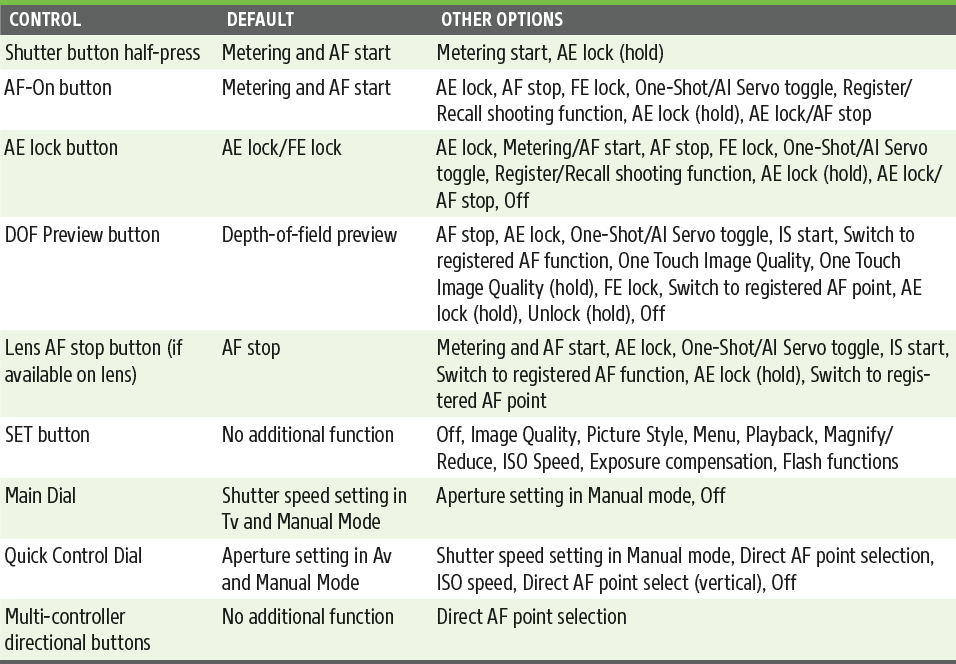
C.Fn III-4: Retract Lens on Power Off
Some gear-driven STM lenses (such as the EF 40mm f/2.8 STM lens) can be set to retract automatically when the 90D is powered down. This setting is a matter of personal preference, but you should make sure the lens is retracted before removing it from the camera.
- 0: Enable
- 1: Disable
C.Fn III-5: Audio Compression
This setting allows turning audio compression for movie shooting on or off.
- 0: Enable. Provides the smallest movie file size at the loss of some sound quality. Audio is also compressed even if Disable is specified when Move Recording Size is set to FHD 29.97/25.0P IPB (NTSC/PAL) or when shooting movies in Basic Zone modes or capturing video snapshots. You can learn more about these in Chapter 10.
- 1: Disable. Offers the best sound, at the cost of larger movie file sizes.
Clear All Custom Func. (C.Fn)
Select this entry and choose Cancel (if you chicken out) or OK to return all your Custom Functions to their default values. But don’t panic—your matrix of Custom Controls is retained. If you want to zero out those settings, you’ll need to do it within the Custom Controls Custom Function, using the Trash button.
My Menu
The Canon EOS 90D has a great feature that allows you to define your own menu, with just the items listed that you want. Remember that the 90D always returns to the last menu and menu entry accessed when you press the MENU button. So you can set up My Menu to include just the items you want, and jump to those items instantly by pressing the MENU button. Or, you can set your camera so that My Menu appears when the MENU button has been pressed, regardless of what other menu entry you accessed last.
To create your own My Menu, you must register the menu items you want to include. Just follow these steps:
- 1. Press the MENU button and use the touch screen or Main Dial to select the My Menu tab. When you first begin, the personalized menu will be empty except for the Add My Menu Tab entry (See Figure 9.16, left.) Choose SET to select it.
- 2. On the Add My Menu Tab page, highlight OK and press SET to create a new tab. The Configure entry will appear.
Figure 9.16 Add a My Menu tab (left) and select items to register (right).
- 3. Highlight Configure and press SET to view the screen shown in Figure 9.16, right.
- 4. Choose Select Items To Register; then press SET.
- 5. Scroll down through the continuous list of menu entries to find one you would like to add. Choose SET.
- 6. Confirm your choice by selecting OK in the next screen and choosing SET again.
- 7. Continue to select up to six menu entries for My Menu.
- 8. When you’re finished, press the MENU button twice to return to the My Menu screen to see your customized menu.
In addition to registering menu items, you can perform other functions at the My Menu Settings screen, including adding additional My Menu Tabs. After you’ve added entries to My Menu, these additional commands may scroll over to a second tab that is automatically created.
After you’ve filled up the My Menu 1 screen, a new option appears: Add My Menu Tab. When the My Menu 2 tab appears, you can fill it with six more entries, as described above. You can add a total of six My Menu tabs to your 90D, an unwieldy number of “quick access” entries, but possible nevertheless.
Your options include:
- Changing the order. Choose Sort Registered Items to reorder the items in My Menu. Select the menu item and choose SET. Use the multi-controller up/down buttons to move the item up and down within the menu list. When you’ve placed it where you’d like it, press SET to lock in your selection and return to the previous screen.
- Delete Selected Items/Delete All Items on Tab. Use these to remove an individual menu item or all menu items you’ve registered in My Menu.
- Delete Tab. Remove an added My Menu tab.
- Rename Tab. Change the name of a tab, using the standard text-entry screen.
- Display from My Menu. As I mentioned earlier, the 90D (almost) always shows the last menu item accessed. That’s convenient if you used My Menu last, but if you happen to use another menu, then pressing the MENU button will return to that item instead. If you enable the Display from My Menu option, you can specify Normal Display (which always displays the last menu accessed), Display from My Menu Tab (which displays the selected My Menu screen), or Display Only My Menu Tab (which displays only the My Menu tab, and hides the Shooting, Playback, Set-up, and Custom Functions tabs).
You might want that option if you choose to work only from your personal set of My Menus (remember, you can create up to six!) and want to ignore all the other menus because, say, you don’t use the features they contain very often. In effect, you’ll be working with your own 1 to 6 menus with only the features you use, displayed on the tabs and in the order you prefer.


